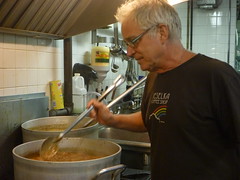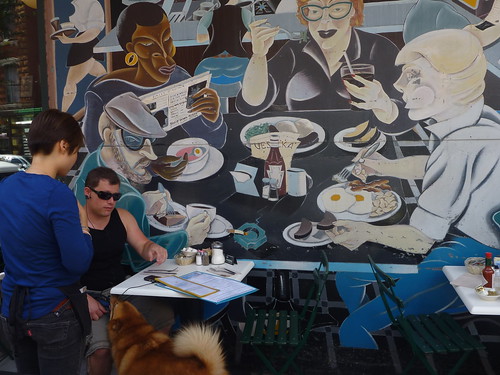 Hannah Rubenstein The owners of the iconic Ukrainian restaurant Veselka are planning a new restaurant on the Bowery.
Hannah Rubenstein The owners of the iconic Ukrainian restaurant Veselka are planning a new restaurant on the Bowery.In a few months there will be a new Veselka Restaurant on the Bowery. Whispers about construction on a Second Avenue subway line prompted Tom Birchard, owner of the iconic East Village Ukrainian restaurant, to take out an unconventional “insurance policy” on his investment: Nine blocks south, in the same building as DBGB Kitchen & Bar, Veselka Bowery is taking shape behind closed doors.
The second Veselka, located on Bowery and First Street, won’t be a carbon-copy of the original — Mr. Birchard said that he hopes the new restaurant will allow him to explore Ukrainian food “at a slightly higher level.” Mr. Birchard’s son Jason will take over the day-to-day operation of the original location at 144 Second Avenue.
The owners of Veselka already operate a café, Little Veselka, near East First Street and First Avenue, which essentially features an abridged version of the Veselka menu — coffee, sandwiches, breakfast food. But Veselka Bowery will be its own restaurant with an entirely different menu and a plan to serve alcohol.
In addition to its request for a liquor license — the original Veselka does not have one — the new restaurant, slated to open by the year’s end, will serve domestic caviar, several types of vodka and chicken kiev. Mr. Birchard hopes this upscale business venture will insulate him from what he views as a very likely consequence of the Second Avenue subway: the destruction of the neighborhood he calls home.
When Mr. Birchard began working as a cashier at his father-in-law’s restaurant in 1967, life in the East Village was rhythmic. Each morning, the restaurant — then a combination candy store and luncheonette — would open its doors to a towering stack of Ukrainian newspapers. One of the employees would carry the stack of papers inside and systematically number them: 59, 60, 61… As the sun rose, one by one, Ukrainian immigrants living in the neighborhood would come into the restaurant and request their newspaper by number. Sometimes they would drop off or pick up neighbors’ keys. Often, they would sit and drink coffee and eat. Always, they would talk.
Since its opening in 1954 by post-World War II Ukrainian refugees Wolodymyr and Olha Darmochawal, the restaurant at Second Avenue and Ninth Street has been at the center of immigrant life in the East Village, particularly among Eastern Europeans. Mr. Birchard, who would come to inherit Veselka upon Wolodymyr’s death in 1975, remembers the restaurant as a “Ukrainian community center,” with an emphasis on “community.”
 Hannah Rubenstein Tom Birchard, owner of Veselka, said he hopes that the new Veselka Bowery will allow him to explore Ukrainian food “at a slightly higher level.”
Hannah Rubenstein Tom Birchard, owner of Veselka, said he hopes that the new Veselka Bowery will allow him to explore Ukrainian food “at a slightly higher level.”“What was the neighborhood like then?” he asked, tilting his head upward, light glinting off his silver hair. “There were fewer people, but the people here knew each other. There was more of a street social scene — people were out and about in the evenings, going to candy stores, sitting in front of their buildings in lawn chairs, socializing. Everybody knew everybody else.” He smiled.
To Mr. Birchard, Veselka, which means “Rainbow” in Ukrainian, was the heart of the East Village, uniting the sprawling veins of its diverse populace. In addition to housing one of the largest Ukrainian communities in the world, the neighborhood was home to Jewish, Italian, Polish and Puerto Rican immigrants — and, beginning in the 1960s, a cacophonous bohemian population of beatniks, hippies and starving artists. “I tell people it was the Haight-Ashbury of the East Coast,” he said.
Nowadays Veselka’s 24-hour dining room still overflows with plates of hand-made sauerkraut pierogis and steaming borscht as in previous decades, but now the diners are more often college students on their way home from bars rather than young immigrants speaking Polish or Russian. No one picks up his daily newspaper by number anymore.
For Mr. Birchard, the change of the neighborhood is lamentable. When he spoke about his home of nearly 50 years, his gaze was direct behind dark-rimmed glasses; his voice matter-of-fact.
“The biggest challenge facing the East Village is maintaining the character of the neighborhood,” he said. “The incredible diverse mix of types of people here created a special environment. I think we’re slowly losing aspects of that.”
As plans to open Veselka Bowery progress, Mr. Birchard is adamant that the menu of the original Veselka won’t change. And his loyalty to the neighborhood he has lived in for half a century won’t change, either. Speaking on behalf of many long-time residents of the East Village, Mr. Birchard says he feels privileged to call the neighborhood home.
“We still like to think that we’re on the cutting edge of being progressive,” he said. “We feel like the neighborhood is something special. It’s something we need to fight to preserve and maintain.”




